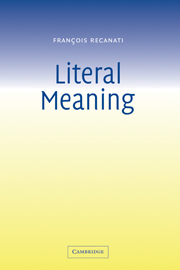Book contents
- Frontmatter
- Contents
- Acknowledgments
- Introduction
- 1 Two approaches to ‘what is said’
- 2 Primary pragmatic processes
- 3 Relevance-theoretic objections
- 4 The Syncretic View
- 5 Non-literal uses
- 6 From Literalism to Contextualism
- 7 Indexicalism and the Binding Fallacy
- 8 Circumstances of evaluation
- 9 Contextualism: how far can we go?
- Conclusion
- Bibliography
- Index
9 - Contextualism: how far can we go?
Published online by Cambridge University Press: 08 January 2010
- Frontmatter
- Contents
- Acknowledgments
- Introduction
- 1 Two approaches to ‘what is said’
- 2 Primary pragmatic processes
- 3 Relevance-theoretic objections
- 4 The Syncretic View
- 5 Non-literal uses
- 6 From Literalism to Contextualism
- 7 Indexicalism and the Binding Fallacy
- 8 Circumstances of evaluation
- 9 Contextualism: how far can we go?
- Conclusion
- Bibliography
- Index
Summary
The modulation of sense
In context the meaning of words is adjusted or ‘modulated’ so as to fit what is being talked about. Sense modulation is essential to speech, because we use a (more or less) fixed stock of lexemes to talk about an indefinite variety of things, situations and experiences. Through the interaction between the context-independent meanings of our words and the particulars of the situation talked about, contextualized, modulated senses emerge, appropriate to the situation at hand. The meaning of a word can thus be made contextually more specific, or it may, on the contrary, be loosened and suitably extended, as in metaphor. It may also undergo ‘semantic transfer’, etc.
According to many authors among those who have studied the phenomenon, modulation is the process whereby the meaning of a given word is affected by the meanings of other words in the same sentence. Thus the meaning of the adjective ‘light’ is affected by the meaning of the noun it modifies: a light lunch is not light in quite the same sense in which a piece of luggage is said to be light. According to Jonathan Cohen, this is one of the big differences between natural language and formal languages: ‘artificial languages satisfy an insulationalist account whereas natural languages require an interactionist one’.
- Type
- Chapter
- Information
- Literal Meaning , pp. 131 - 153Publisher: Cambridge University PressPrint publication year: 2003



